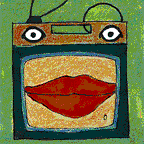 |
Zoetropes, Flipbooks To the right is the first version of TV Dinner; a 12 image cycle animated for a zoetrope strip. |
 |
In narrative theory, the practice of describing a repeating event only once is known as the iterative. Storytellers (including filmmakers and animators) find the iterative useful to establish context at the beginning of a story. For example, "Every morning, when we turned on the TV, a big mouth on the screen opened." The mouth opening on TV is a repeated event. But there won't be a story unless some change sets the plot in motion. "This morning, when we turned on the TV, the mouth opened, shot out its tongue like a hungry frog and...." (Order the flipbook to find out the end of that story!) |
|
| You may save on shipping costs by ordering from HEEZA in Paris. |
|
|
 |
Copyright Ruth Hayes 2023